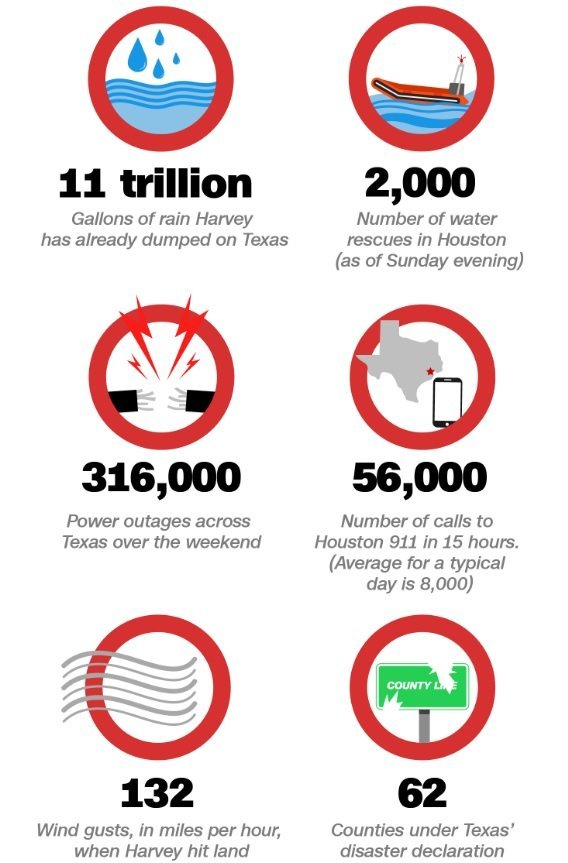TEXAS — As Harvey’s rainfall tapered off over the weekend in Texas, the region is starting to take stock of the damage as it enters the next phase of recovery.
Cleanup efforts are underway after the deadly storm. But, with rivers still full and floodwaters only starting to recede, officials say it will be a long time before the full extent of the damage reveals itself.
Toxic waste sites flooded
At least 13 toxic waste sites in Texas were flooded or damaged by Hurricane Harvey, according to the Environmental Protection Agency.
The agency announced Saturday that it had assessed 41 Superfund sites using aerial images, and determined the ones badly affected by the storm.
The impact of flooding on the sites is unknown. The EPA said its workers have not been able to “safely access the sites” but are ready to do so as soon as the floodwaters recede. In the Houston area, authorities had said it would take 10-15 days for floodwaters to recede.
A Superfund site is land that is contaminated by hazardous waste and identified by the EPA as a candidate for cleanup because it poses a risk to human health and/or the environment. The 13 affected sites have industrial waste from petrochemical companies, acid compounds, solvents and pesticides.
More challenges

The toxic waste sites are the latest environmental threat to emerge since Harvey swept through the region.
Fires broke out over two days at a flooded chemical plant near Houston.
People living within 1.5 miles from the Arkema site in Crosby were evacuated days before the explosions. The evacuation order was lifted early Monday morning after local officials determined it was safe to let residents return home.
Officials have been letting chemical containers catch fire and burn out rather than endanger firefighters, the EPA and the Texas Commission on Environmental Quality said in a joint statement.
The Superfund sites and the Arkema plant represent just a snapshot of the catastrophic storm’s cascading effects.
As of Saturday, 2,300 of the 4,500 drinking water systems potentially affected by Harvey have been contacted, the EPA said. Of those, 1,514 systems are fully operational, 166 have boil-water notices, and 50 are shut down. As for wastewater and sewage, 1,656 of about 2,469 wastewater treatment plants are fully operational in affected counties.
Mayor: Houston open for business
Houston Mayor Sylvester Turner and Texas Gov. Greg Abbott both appeared Sunday on morning talk shows.
Most of Houston is operational and more than 95% of the city is dry, Turner said on CBS’ “Face the Nation.” Most businesses will reopen Tuesday, he added.
“And so if you have a conference, a convention, a concert, any of those things that were planned, that you were planning to come to this city, we are still ready to welcome you,” he said. “On Tuesday we are getting back on our feet, and I’m expecting employees — employers to open, employees to go to work. And all city employees, you are due back at work on Tuesday.”
But Turner said residents are still struggling and first responders will go door-to-door to check on the elderly, housing conditions and disabled people.
Abbott said on CNN’s “State of the Union” that his state was going to need a massive commitment from the federal government as it begins to recover from the storm.
The recovery from Harvey will require even more money than the package Congress appropriated for Hurricane Katrina relief, he said. The total population and geographic range affected by Harvey could surpass Hurricane Katrina and Hurricane Sandy combined, he said.
“It’s going to take years for us to be able to overcome this challenge,” Abbott said.
‘Please don’t come home’
More than a week after Hurricane Harvey swept through Texas, thousands of people are still unable to return home. At least 53 people died from the storm and tens of thousands of people are still living in shelters seeking aid.
“Please don’t come home,” Brazoria County Judge Matt Sebesta said at a news conference Saturday.
Residents were evacuated last week when floodwaters breached a levee in the county south of Houston. Water is going through septic systems in rural areas, creating a health hazard for residents. “It’s like a huge lake sliding across the county,” he said.
In Houston, nearly 300 people who chose to stay in flooded homes after Hurricane Harvey are expected to evacuate before the CenterPoint Energy utility turns off power to those residences.
Mayor Turner ordered the evacuation after emergency workers scouted the area Friday and learned that many people had not left their flooded homes. Areas of western Houston have seen sustained flooding in part because the Army Corps of Engineers has intentionally released water from two swollen reservoirs, and the flooding there won’t recede soon, Turner said.
Mexico set to send help
Relief supplies and up to 50 Mexican medical professionals will soon cross the border to help thousands of flood evacuees in Texas, Mexican officials said.
Mexico offered the United States aid days ago, and Texas officials gave Mexico the green light Saturday to start sending help, said Carlos Manuel Sada, Mexico’s undersecretary for North-American relations.
More than a dozen trailers loaded with beds, portable generators, mobile community kitchens and other supplies will cross the border into Laredo, Texas, “in the coming days,” and be transported by land to the Houston area.
“On top of everything, there is a deep relationship between Mexico and Texas,” Sada said.
In 2005, Mexico sent drinking water and a convoy of soldiers among other supplies to help Hurricane Katrina victims.
As the government works to help those affected by Harvey, Hurricane Irma is looming in the Atlantic as a threat to Caribbean islands — and potentially, by next week, to the United States.





















